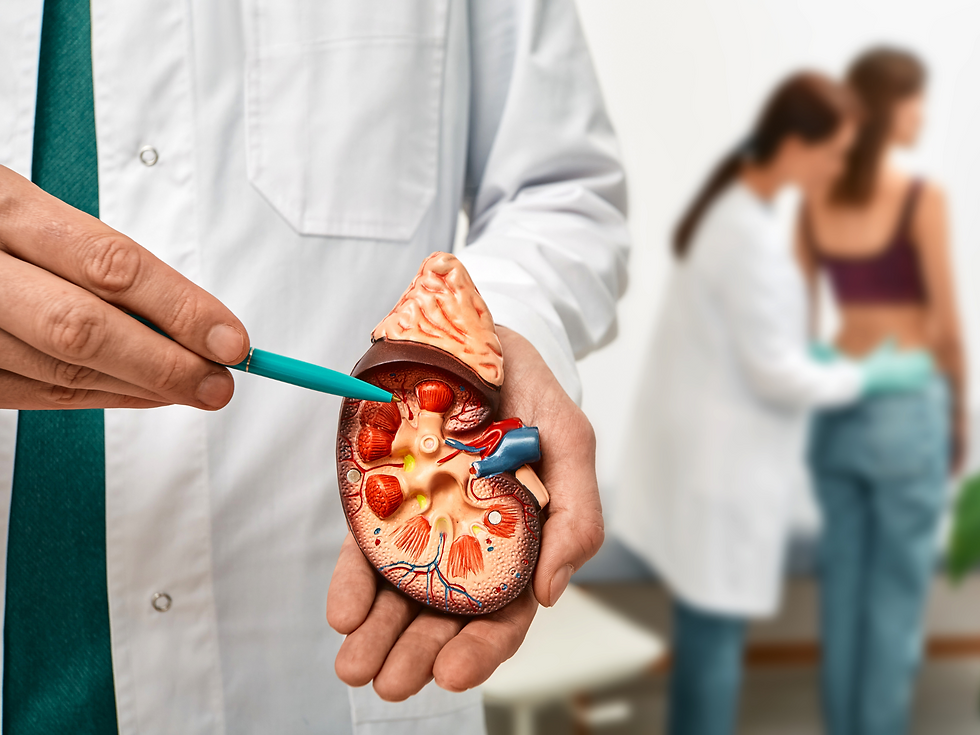End-Stage Renal Disease (ESRD): Understanding Your Treatment Options
- Saeed Zafar
- Mar 20
- 2 min read

When kidney function declines to less than 15% of its normal capacity, it is classified as End-Stage Renal Disease (ESRD). At this stage, the kidneys can no longer remove waste and excess fluids from the body effectively, leading to life-threatening complications. Treatment is necessary for survival, and the two main options are dialysis or a kidney transplant.
If you or a loved one has been diagnosed with ESRD, understanding your treatment choices is crucial. Here are the primary dialysis options available:
1) At-Home Peritoneal Dialysis (PD)
Peritoneal dialysis is a convenient at-home treatment that uses the body's natural peritoneal membrane (inside the abdomen) to filter toxins and excess fluids from the blood. A special fluid is introduced into the abdominal cavity and later drained, removing waste products.
✅ Advantages:
Can be done at home, work, or even while sleeping
No needles required
Offers greater flexibility and independence
Provides more steady removal of toxins, reducing dietary restrictions
🚨 Considerations:
Requires commitment to daily treatments
Risk of infection (peritonitis) if hygiene is not maintained
Not suitable for all patients, especially those with prior abdominal surgeries
2) At-Home Hemodialysis (HHD)
Home hemodialysis allows patients to filter their blood at home using a dialysis machine. It requires a vascular access point (typically in the arm), where blood is drawn, cleaned through a machine, and returned to the body.
✅ Advantages:
More frequent, shorter treatments can improve well-being
Greater flexibility in scheduling dialysis sessions
Fewer dietary and fluid restrictions compared to in-center dialysis
🚨 Considerations:
Requires special training for patients and/or caregivers
Involves needles and access care to prevent infection
Requires space in the home for dialysis equipment
3) In-Center Hemodialysis
In-center hemodialysis is the most common form of dialysis, performed at a dialysis clinic under medical supervision. Patients typically visit 3 times a week for 3-4 hour sessions, during which their blood is filtered through a dialysis machine.
✅ Advantages:
Supervised by medical professionals
No need to store or manage equipment at home
Social interaction with other patients during sessions
🚨 Considerations:
Requires travel to a dialysis center multiple times per week
Longer recovery time after sessions due to fluid and toxin removal happening in larger amounts
More dietary and fluid restrictions compared to home dialysis options
Kidney Transplant: A Long-Term Solution
For eligible patients, a kidney transplant offers the best chance at a more normal life, eliminating the need for dialysis. A healthy kidney from a living or deceased donor is transplanted into the patient’s body. While this is a major procedure, it can greatly improve quality of life and longevity.
However, challenges include:
Long waiting lists for donor kidneys
The need for lifelong immunosuppressive medications
Potential risks of surgery and rejection of the new kidney
Which Treatment is Right for You?
Choosing the right treatment depends on your health, lifestyle, and personal preferences. At Kidney and Hypertension Associates, we specialize in helping ESRD patients navigate their options and find the best treatment plan.
📞 Call us today at +1 706-322-8820 to schedule a consultation!
📍 Visit us at 2032 Wynnton Rd #A, Columbus, GA 31906
Your kidney health is our priority—we're here to support you every step of the way!


Comments